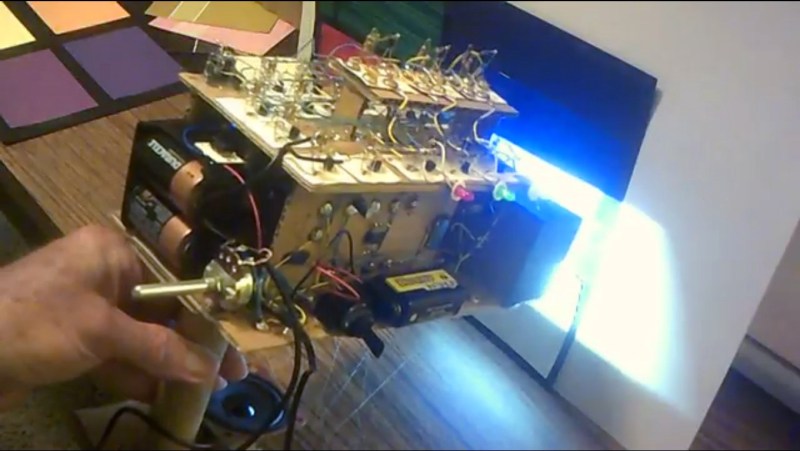[Dr. Cockroach] has delighted us again with another of his circuits on cardboard. He calls it steampunk inspired, and while we guess we can see what he’s getting at, it’s more like a sweet example of artful dead bug construction. He calls it the ColorChord. Point its photo cells at a color and it’ll play a tone or a combination of tones specific to that color.
Three 555-centric boards use thumbtacks as connection points which he solders to, the same technique he used for his cardboard computer. They provide simple tones for red, green, and blue and a mix for any other color. However, he found that the tones weren’t distinguishable enough for similar colors like a bright sun yellow and a reddish yellow. So he ended up pulsing them using master oscillator, master-slave flip-flop, and sequencer circuits, all done dead bug style.
We’re not sure how practical it is but the various pulsed tones remind us of the B space movies of the 1950s and 60s. And as for the look of it, well it’s just plain fun to look at. Hear and see it for yourself in the video below.
And if you want to see some dead bug circuitry as high art then check out this awesome LED ring, this sculptural nixie clock, and perhaps the most wondrous of all, The Clock.
















So Dr. Cockroach has given the user auditory input of three points along the visual spectrum. Great!! It does beg the question of how far one can take it. The visual spectrum is a continuum and so is the auditory spectrum. I wonder how formidable the barriers would be to fully utilize auditory spectrum to get as much visual spectrum across as possible. Who knows, perhaps an experienced user of such a device could pick out good fruit from bad fruit better than anyone. It’s only with a 1×1 resolution but the color info would be vastly superior. People could take you along just to look at things with your own special perspective, kind of like what Captain Pickard did with Jordi LaForge in Star Trek The Next Generation. Way cool concept.
Interestingly, such a device could be worn on the face where the eyes are and extend back to the ears for support and to channel earbuds to the ears, not a far cry from Jordi’s visor in form factor. ????
Imagine the headaches of listinening to such a device. – Jordi got headaches too. :-)
There’s a similar project published 3+ years ago
https://hackaday.io/project/5778-listen-to-the-colours
That is a great compact design, Mine is more art than something to be carried around :-)
I really like the glue-gunning discretes to cardboard concept. It sort of hits that sweet spot between soldering to circuit board and bread-boarding. More flexible than circuit boards and more durable than bread-boarding. It could help with speed in prototyping. (It also gives your work a kind of special Doctor Emmit Brown style. :-) ) ????
I’d not do things like that, but it is an exercise in “doing” so each to his own methods… I’d use a piece of CD and an old linear CCD chip out of a scanner to generate a spectral plot then use FM synthesis to generate the sound.
Funny, ColorChord is also the name of a program made by [CnLohr] to do almost the exact opposite : display colors depending on sound. But the goal is different, it’s about visual effects accompanying music.
Ditto
So, am I the only one out there pondering the impractical idea of setting the output of one into the input of the other just for fun. Sort of like using google translate to go from English –> Hungarian –> English just to see what happens. Totally impractical but fun to think about. :-)
Muphins: My friend Will just linked me this project and based on the title I was like “woohoo someone who did something with it made hackaday” then I realized! But no such luck.
Instead it was a very cool thing, but man that would be cool to hook them into each other. Too bad it looks like the mapping is very different. Would be very interesting none the less. Hopefully [Dr. Cockroach] see this thread and gets a little NodeMCU and some WS2812 strip to give it a whirl.
Any chance of getting more videos about how ColorChord works sometime?
This is about as close as I can get… https://www.youtube.com/watch?v=qE3zEM8qM00
So, it’s a three-channel inverse color organ. How 1960s!